HEALT 2114 Task 2a: Diabetes and Indigenous Health Disparities
VerifiedAdded on 2022/10/13
|8
|1791
|165
Essay
AI Summary
This essay investigates diabetes as a significant health concern among Aboriginal and Torres Strait Islander peoples, highlighting their increased morbidity and mortality rates compared to non-Indigenous Australians. The essay examines the burden of diabetes, emphasizing its contribution to the life expectancy gap and increased hospitalizations. It explores the impact of social determinants of health, such as income inequalities, poverty, and historical factors like colonization, on the development and progression of diabetes within these communities. Additionally, the essay discusses cultural implications and obstacles that hinder effective diabetes management, such as competing demands and limited access to healthcare resources. The conclusion stresses the need for intersectional collaborations and culturally sensitive public health interventions, including community engagement and awareness campaigns, to reduce the prevalence and burden of diabetes among Indigenous Australians. The essay is supported by current statistics and research, and it suggests strategies for addressing the issue.
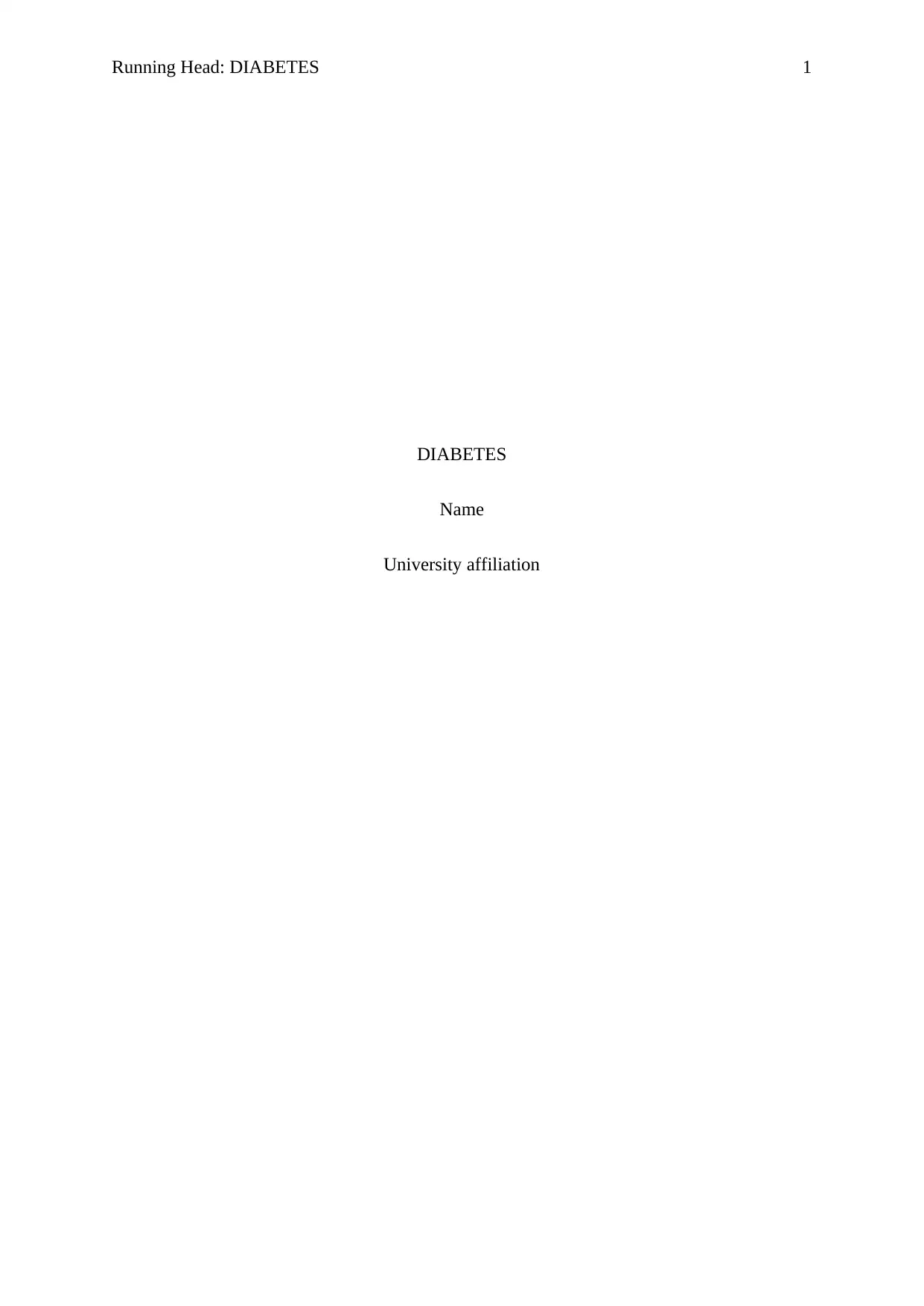
Running Head: DIABETES 1
DIABETES
Name
University affiliation
DIABETES
Name
University affiliation
Paraphrase This Document
Need a fresh take? Get an instant paraphrase of this document with our AI Paraphraser
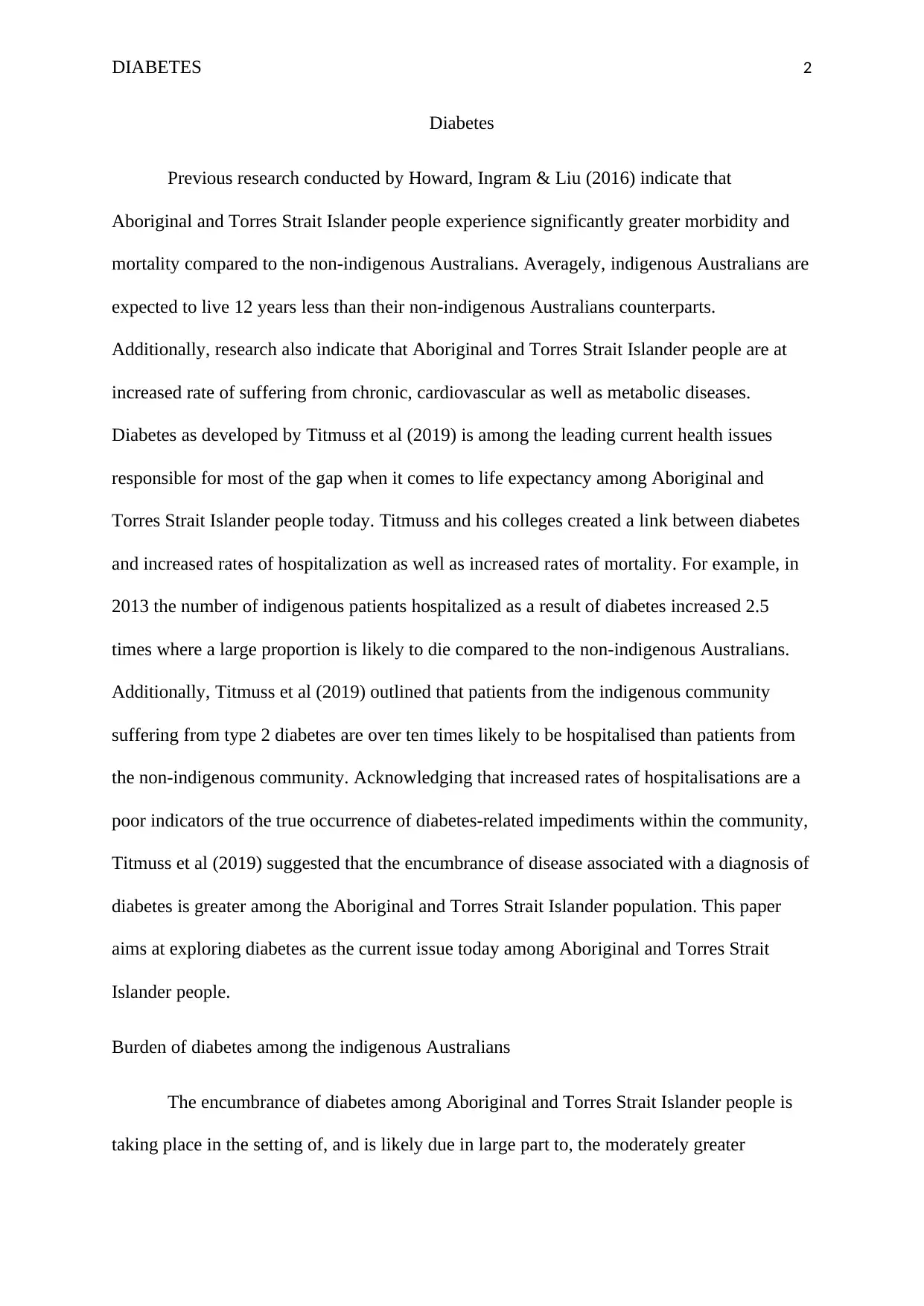
DIABETES 2
Diabetes
Previous research conducted by Howard, Ingram & Liu (2016) indicate that
Aboriginal and Torres Strait Islander people experience significantly greater morbidity and
mortality compared to the non-indigenous Australians. Averagely, indigenous Australians are
expected to live 12 years less than their non-indigenous Australians counterparts.
Additionally, research also indicate that Aboriginal and Torres Strait Islander people are at
increased rate of suffering from chronic, cardiovascular as well as metabolic diseases.
Diabetes as developed by Titmuss et al (2019) is among the leading current health issues
responsible for most of the gap when it comes to life expectancy among Aboriginal and
Torres Strait Islander people today. Titmuss and his colleges created a link between diabetes
and increased rates of hospitalization as well as increased rates of mortality. For example, in
2013 the number of indigenous patients hospitalized as a result of diabetes increased 2.5
times where a large proportion is likely to die compared to the non-indigenous Australians.
Additionally, Titmuss et al (2019) outlined that patients from the indigenous community
suffering from type 2 diabetes are over ten times likely to be hospitalised than patients from
the non-indigenous community. Acknowledging that increased rates of hospitalisations are a
poor indicators of the true occurrence of diabetes‐related impediments within the community,
Titmuss et al (2019) suggested that the encumbrance of disease associated with a diagnosis of
diabetes is greater among the Aboriginal and Torres Strait Islander population. This paper
aims at exploring diabetes as the current issue today among Aboriginal and Torres Strait
Islander people.
Burden of diabetes among the indigenous Australians
The encumbrance of diabetes among Aboriginal and Torres Strait Islander people is
taking place in the setting of, and is likely due in large part to, the moderately greater
Diabetes
Previous research conducted by Howard, Ingram & Liu (2016) indicate that
Aboriginal and Torres Strait Islander people experience significantly greater morbidity and
mortality compared to the non-indigenous Australians. Averagely, indigenous Australians are
expected to live 12 years less than their non-indigenous Australians counterparts.
Additionally, research also indicate that Aboriginal and Torres Strait Islander people are at
increased rate of suffering from chronic, cardiovascular as well as metabolic diseases.
Diabetes as developed by Titmuss et al (2019) is among the leading current health issues
responsible for most of the gap when it comes to life expectancy among Aboriginal and
Torres Strait Islander people today. Titmuss and his colleges created a link between diabetes
and increased rates of hospitalization as well as increased rates of mortality. For example, in
2013 the number of indigenous patients hospitalized as a result of diabetes increased 2.5
times where a large proportion is likely to die compared to the non-indigenous Australians.
Additionally, Titmuss et al (2019) outlined that patients from the indigenous community
suffering from type 2 diabetes are over ten times likely to be hospitalised than patients from
the non-indigenous community. Acknowledging that increased rates of hospitalisations are a
poor indicators of the true occurrence of diabetes‐related impediments within the community,
Titmuss et al (2019) suggested that the encumbrance of disease associated with a diagnosis of
diabetes is greater among the Aboriginal and Torres Strait Islander population. This paper
aims at exploring diabetes as the current issue today among Aboriginal and Torres Strait
Islander people.
Burden of diabetes among the indigenous Australians
The encumbrance of diabetes among Aboriginal and Torres Strait Islander people is
taking place in the setting of, and is likely due in large part to, the moderately greater
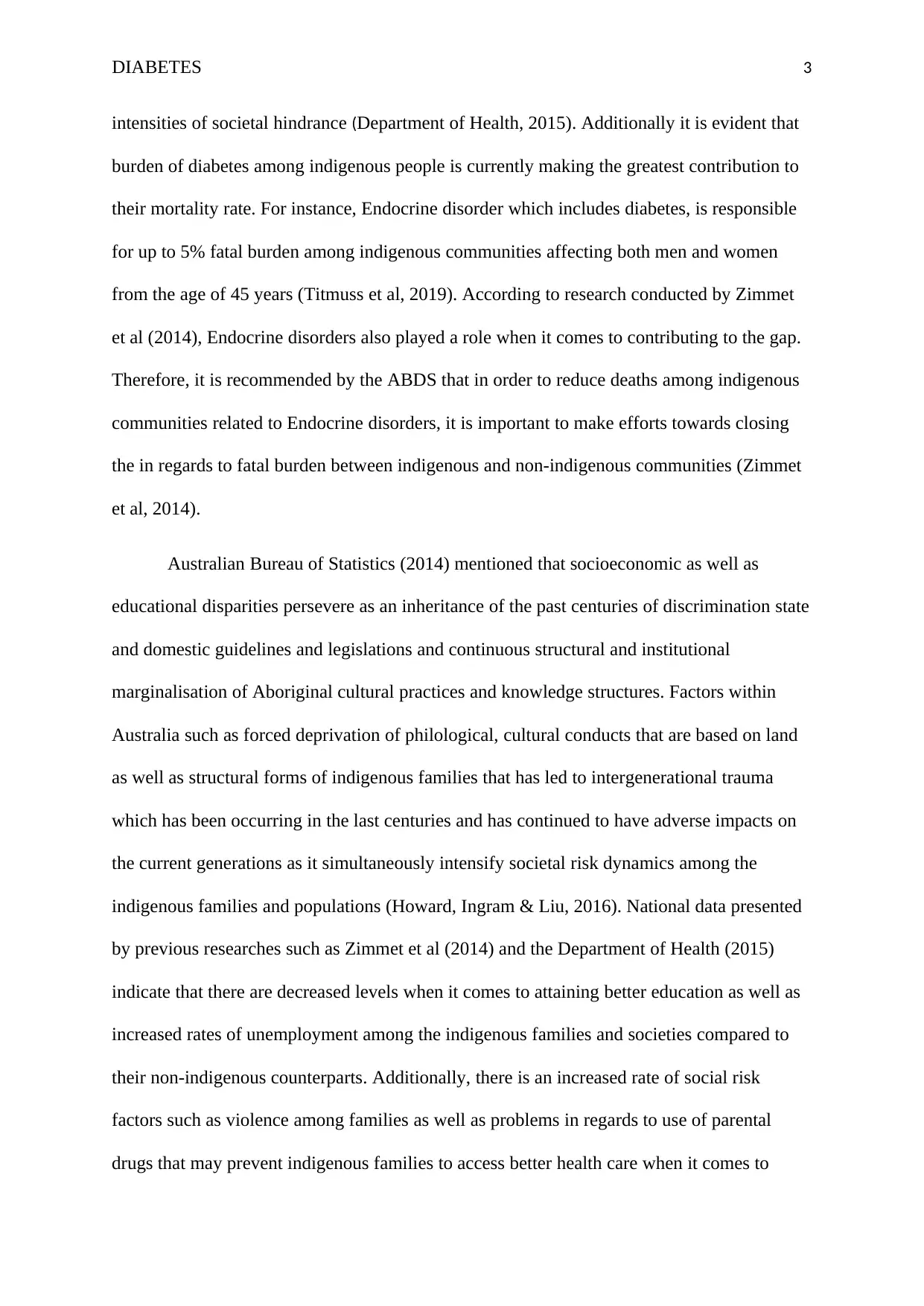
DIABETES 3
intensities of societal hindrance (Department of Health, 2015). Additionally it is evident that
burden of diabetes among indigenous people is currently making the greatest contribution to
their mortality rate. For instance, Endocrine disorder which includes diabetes, is responsible
for up to 5% fatal burden among indigenous communities affecting both men and women
from the age of 45 years (Titmuss et al, 2019). According to research conducted by Zimmet
et al (2014), Endocrine disorders also played a role when it comes to contributing to the gap.
Therefore, it is recommended by the ABDS that in order to reduce deaths among indigenous
communities related to Endocrine disorders, it is important to make efforts towards closing
the in regards to fatal burden between indigenous and non-indigenous communities (Zimmet
et al, 2014).
Australian Bureau of Statistics (2014) mentioned that socioeconomic as well as
educational disparities persevere as an inheritance of the past centuries of discrimination state
and domestic guidelines and legislations and continuous structural and institutional
marginalisation of Aboriginal cultural practices and knowledge structures. Factors within
Australia such as forced deprivation of philological, cultural conducts that are based on land
as well as structural forms of indigenous families that has led to intergenerational trauma
which has been occurring in the last centuries and has continued to have adverse impacts on
the current generations as it simultaneously intensify societal risk dynamics among the
indigenous families and populations (Howard, Ingram & Liu, 2016). National data presented
by previous researches such as Zimmet et al (2014) and the Department of Health (2015)
indicate that there are decreased levels when it comes to attaining better education as well as
increased rates of unemployment among the indigenous families and societies compared to
their non-indigenous counterparts. Additionally, there is an increased rate of social risk
factors such as violence among families as well as problems in regards to use of parental
drugs that may prevent indigenous families to access better health care when it comes to
intensities of societal hindrance (Department of Health, 2015). Additionally it is evident that
burden of diabetes among indigenous people is currently making the greatest contribution to
their mortality rate. For instance, Endocrine disorder which includes diabetes, is responsible
for up to 5% fatal burden among indigenous communities affecting both men and women
from the age of 45 years (Titmuss et al, 2019). According to research conducted by Zimmet
et al (2014), Endocrine disorders also played a role when it comes to contributing to the gap.
Therefore, it is recommended by the ABDS that in order to reduce deaths among indigenous
communities related to Endocrine disorders, it is important to make efforts towards closing
the in regards to fatal burden between indigenous and non-indigenous communities (Zimmet
et al, 2014).
Australian Bureau of Statistics (2014) mentioned that socioeconomic as well as
educational disparities persevere as an inheritance of the past centuries of discrimination state
and domestic guidelines and legislations and continuous structural and institutional
marginalisation of Aboriginal cultural practices and knowledge structures. Factors within
Australia such as forced deprivation of philological, cultural conducts that are based on land
as well as structural forms of indigenous families that has led to intergenerational trauma
which has been occurring in the last centuries and has continued to have adverse impacts on
the current generations as it simultaneously intensify societal risk dynamics among the
indigenous families and populations (Howard, Ingram & Liu, 2016). National data presented
by previous researches such as Zimmet et al (2014) and the Department of Health (2015)
indicate that there are decreased levels when it comes to attaining better education as well as
increased rates of unemployment among the indigenous families and societies compared to
their non-indigenous counterparts. Additionally, there is an increased rate of social risk
factors such as violence among families as well as problems in regards to use of parental
drugs that may prevent indigenous families to access better health care when it comes to
⊘ This is a preview!⊘
Do you want full access?
Subscribe today to unlock all pages.

Trusted by 1+ million students worldwide

DIABETES 4
diabetes (Howard, Ingram & Liu, 2016). For instance, Zimmet et al (2014) during his study
developed that there was an increased rate of hospital admission cases in regards to
interpersonal violence during the last few years in Western Australia. The study also
mentioned that the cases increased over 10 times among indigenous families compared to
their non-indigenous counterparts where women are most at risk. Naturally, ambulatory care-
sensitive circumstances such diabetes and other chronic diseases are accountable for the
highest and increase percentage of general admissions among indigenous people compared to
their non-Aboriginal counterparts. Other reports such as Diabetes Australia (2015) have
demonstrated that diabetes as a current health issues among indigenous families especially
among elderly adults tends to have adverse effects not only in their own quality of life but to
that of their families as well.
Impacts of social determinants of health on the development and progression of diabetes.
Researchers such as Jackson et al (2010); Department of Health (2015) and
HealthInfoNet et al (2019) have argued that income inequalities as well as poverty levels in
Australia are more important impacts of social determinants when it comes to health care
more than absolute per capita affluences. Evidence from the Australian Bureau of Statistics
(2014) reveal that Australia is experiencing an increased gap in regards to the incomes levels
between Aboriginal and non-indigenous people. From the context of Australia, individuals
found at the lowest end of the scale of incomes such as people from indigenous communities
live in relative poverty in which they have no access to better health care services. According
to HealthInfoNet et al (2019) indigenous people especially in Australia tend to be socially
marginalised due to lack of material resources disqualifies pattern when it comes to
consumption as they are simultaneously unable to participate in what is termed as the
Australian way life such as access to better health care amenities
diabetes (Howard, Ingram & Liu, 2016). For instance, Zimmet et al (2014) during his study
developed that there was an increased rate of hospital admission cases in regards to
interpersonal violence during the last few years in Western Australia. The study also
mentioned that the cases increased over 10 times among indigenous families compared to
their non-indigenous counterparts where women are most at risk. Naturally, ambulatory care-
sensitive circumstances such diabetes and other chronic diseases are accountable for the
highest and increase percentage of general admissions among indigenous people compared to
their non-Aboriginal counterparts. Other reports such as Diabetes Australia (2015) have
demonstrated that diabetes as a current health issues among indigenous families especially
among elderly adults tends to have adverse effects not only in their own quality of life but to
that of their families as well.
Impacts of social determinants of health on the development and progression of diabetes.
Researchers such as Jackson et al (2010); Department of Health (2015) and
HealthInfoNet et al (2019) have argued that income inequalities as well as poverty levels in
Australia are more important impacts of social determinants when it comes to health care
more than absolute per capita affluences. Evidence from the Australian Bureau of Statistics
(2014) reveal that Australia is experiencing an increased gap in regards to the incomes levels
between Aboriginal and non-indigenous people. From the context of Australia, individuals
found at the lowest end of the scale of incomes such as people from indigenous communities
live in relative poverty in which they have no access to better health care services. According
to HealthInfoNet et al (2019) indigenous people especially in Australia tend to be socially
marginalised due to lack of material resources disqualifies pattern when it comes to
consumption as they are simultaneously unable to participate in what is termed as the
Australian way life such as access to better health care amenities
Paraphrase This Document
Need a fresh take? Get an instant paraphrase of this document with our AI Paraphraser
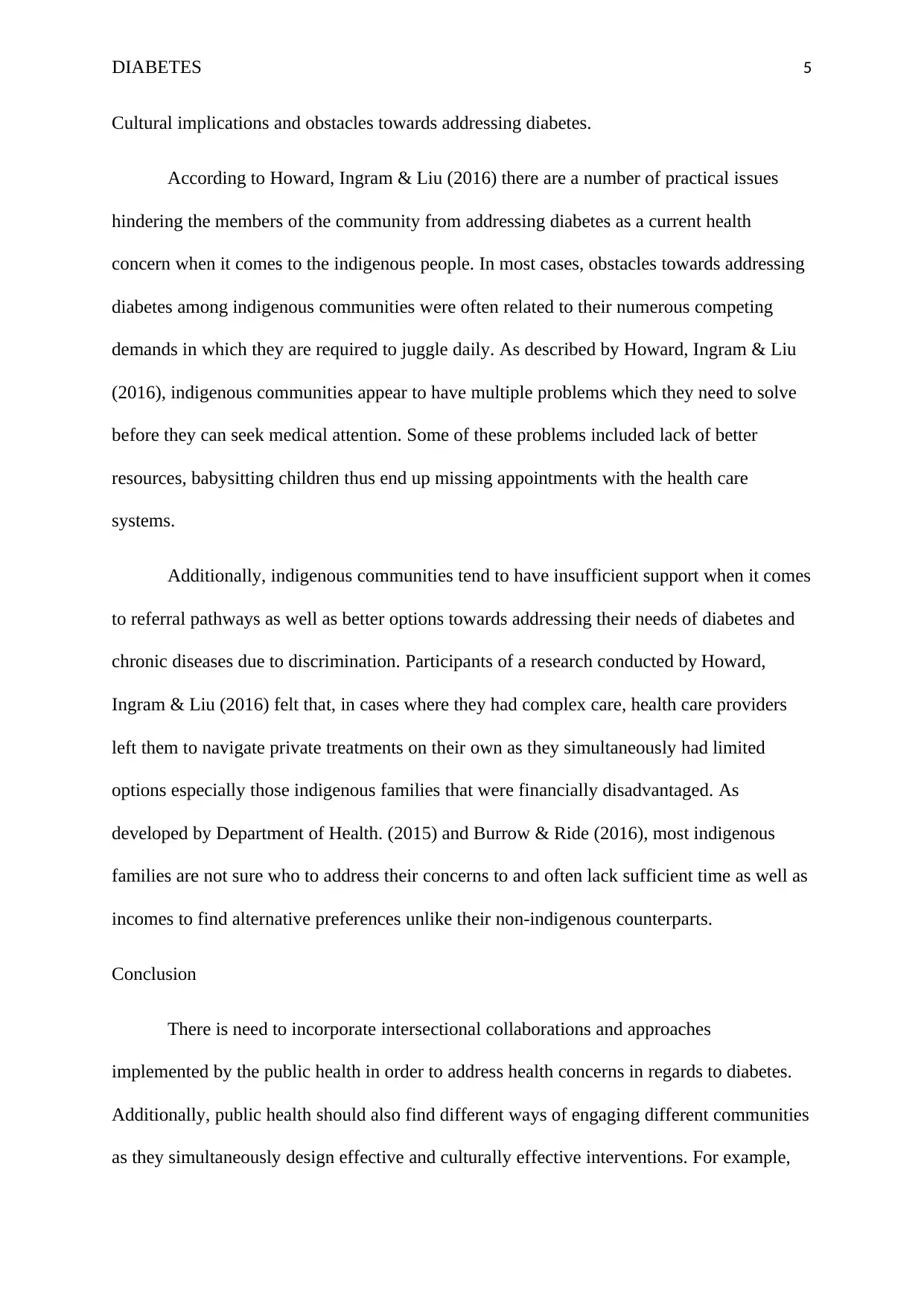
DIABETES 5
Cultural implications and obstacles towards addressing diabetes.
According to Howard, Ingram & Liu (2016) there are a number of practical issues
hindering the members of the community from addressing diabetes as a current health
concern when it comes to the indigenous people. In most cases, obstacles towards addressing
diabetes among indigenous communities were often related to their numerous competing
demands in which they are required to juggle daily. As described by Howard, Ingram & Liu
(2016), indigenous communities appear to have multiple problems which they need to solve
before they can seek medical attention. Some of these problems included lack of better
resources, babysitting children thus end up missing appointments with the health care
systems.
Additionally, indigenous communities tend to have insufficient support when it comes
to referral pathways as well as better options towards addressing their needs of diabetes and
chronic diseases due to discrimination. Participants of a research conducted by Howard,
Ingram & Liu (2016) felt that, in cases where they had complex care, health care providers
left them to navigate private treatments on their own as they simultaneously had limited
options especially those indigenous families that were financially disadvantaged. As
developed by Department of Health. (2015) and Burrow & Ride (2016), most indigenous
families are not sure who to address their concerns to and often lack sufficient time as well as
incomes to find alternative preferences unlike their non-indigenous counterparts.
Conclusion
There is need to incorporate intersectional collaborations and approaches
implemented by the public health in order to address health concerns in regards to diabetes.
Additionally, public health should also find different ways of engaging different communities
as they simultaneously design effective and culturally effective interventions. For example,
Cultural implications and obstacles towards addressing diabetes.
According to Howard, Ingram & Liu (2016) there are a number of practical issues
hindering the members of the community from addressing diabetes as a current health
concern when it comes to the indigenous people. In most cases, obstacles towards addressing
diabetes among indigenous communities were often related to their numerous competing
demands in which they are required to juggle daily. As described by Howard, Ingram & Liu
(2016), indigenous communities appear to have multiple problems which they need to solve
before they can seek medical attention. Some of these problems included lack of better
resources, babysitting children thus end up missing appointments with the health care
systems.
Additionally, indigenous communities tend to have insufficient support when it comes
to referral pathways as well as better options towards addressing their needs of diabetes and
chronic diseases due to discrimination. Participants of a research conducted by Howard,
Ingram & Liu (2016) felt that, in cases where they had complex care, health care providers
left them to navigate private treatments on their own as they simultaneously had limited
options especially those indigenous families that were financially disadvantaged. As
developed by Department of Health. (2015) and Burrow & Ride (2016), most indigenous
families are not sure who to address their concerns to and often lack sufficient time as well as
incomes to find alternative preferences unlike their non-indigenous counterparts.
Conclusion
There is need to incorporate intersectional collaborations and approaches
implemented by the public health in order to address health concerns in regards to diabetes.
Additionally, public health should also find different ways of engaging different communities
as they simultaneously design effective and culturally effective interventions. For example,
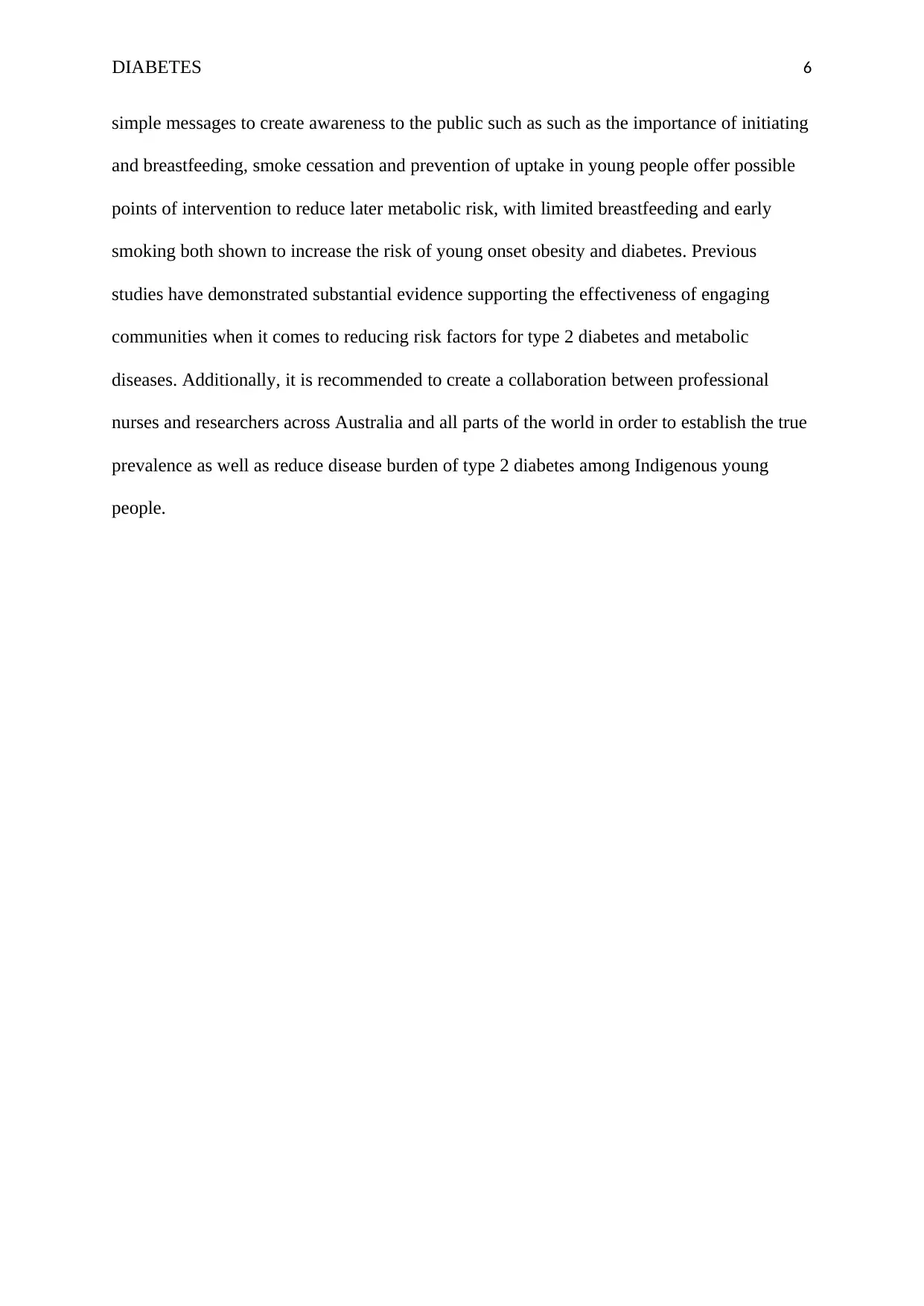
DIABETES 6
simple messages to create awareness to the public such as such as the importance of initiating
and breastfeeding, smoke cessation and prevention of uptake in young people offer possible
points of intervention to reduce later metabolic risk, with limited breastfeeding and early
smoking both shown to increase the risk of young onset obesity and diabetes. Previous
studies have demonstrated substantial evidence supporting the effectiveness of engaging
communities when it comes to reducing risk factors for type 2 diabetes and metabolic
diseases. Additionally, it is recommended to create a collaboration between professional
nurses and researchers across Australia and all parts of the world in order to establish the true
prevalence as well as reduce disease burden of type 2 diabetes among Indigenous young
people.
simple messages to create awareness to the public such as such as the importance of initiating
and breastfeeding, smoke cessation and prevention of uptake in young people offer possible
points of intervention to reduce later metabolic risk, with limited breastfeeding and early
smoking both shown to increase the risk of young onset obesity and diabetes. Previous
studies have demonstrated substantial evidence supporting the effectiveness of engaging
communities when it comes to reducing risk factors for type 2 diabetes and metabolic
diseases. Additionally, it is recommended to create a collaboration between professional
nurses and researchers across Australia and all parts of the world in order to establish the true
prevalence as well as reduce disease burden of type 2 diabetes among Indigenous young
people.
⊘ This is a preview!⊘
Do you want full access?
Subscribe today to unlock all pages.

Trusted by 1+ million students worldwide
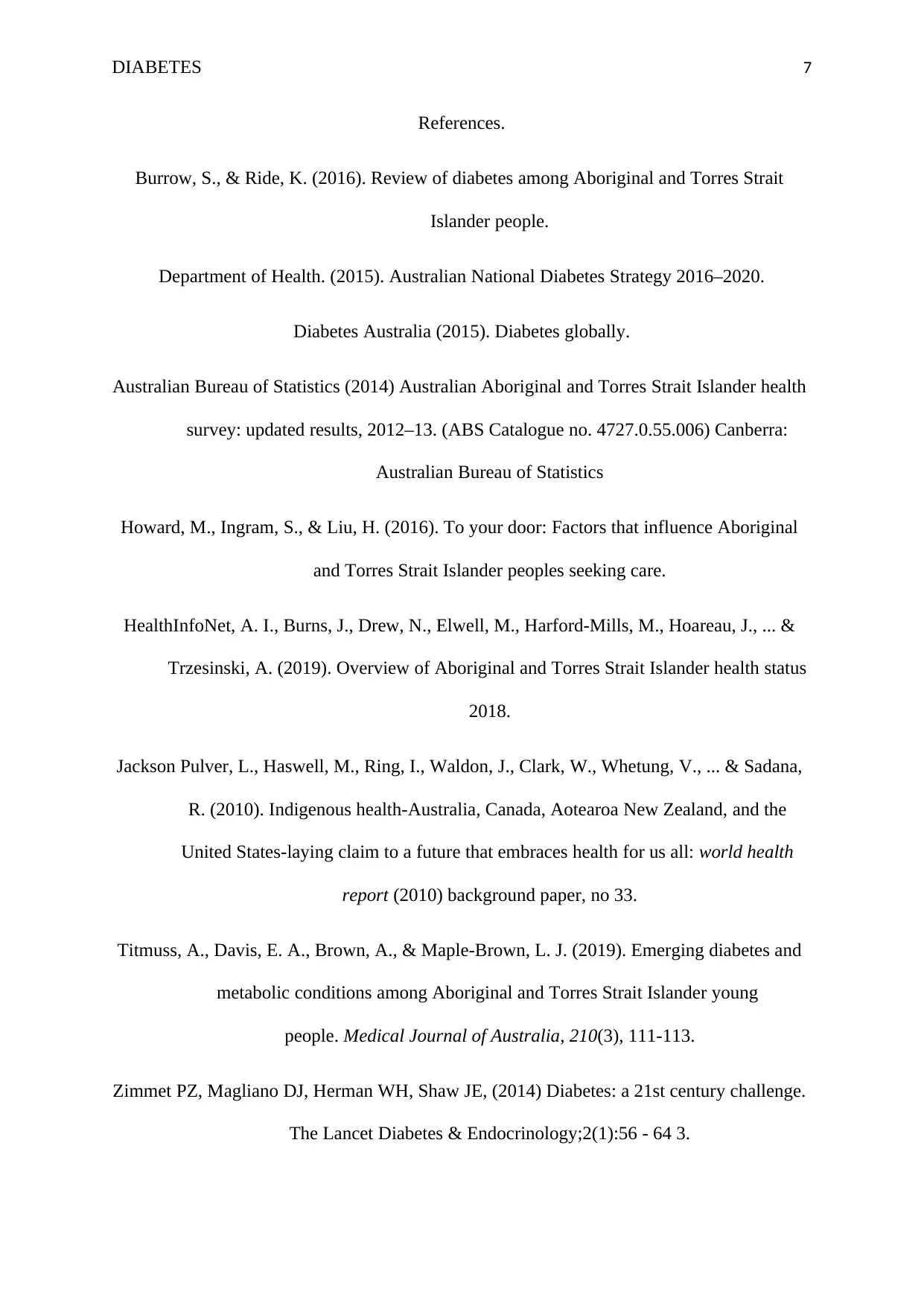
DIABETES 7
References.
Burrow, S., & Ride, K. (2016). Review of diabetes among Aboriginal and Torres Strait
Islander people.
Department of Health. (2015). Australian National Diabetes Strategy 2016–2020.
Diabetes Australia (2015). Diabetes globally.
Australian Bureau of Statistics (2014) Australian Aboriginal and Torres Strait Islander health
survey: updated results, 2012–13. (ABS Catalogue no. 4727.0.55.006) Canberra:
Australian Bureau of Statistics
Howard, M., Ingram, S., & Liu, H. (2016). To your door: Factors that influence Aboriginal
and Torres Strait Islander peoples seeking care.
HealthInfoNet, A. I., Burns, J., Drew, N., Elwell, M., Harford-Mills, M., Hoareau, J., ... &
Trzesinski, A. (2019). Overview of Aboriginal and Torres Strait Islander health status
2018.
Jackson Pulver, L., Haswell, M., Ring, I., Waldon, J., Clark, W., Whetung, V., ... & Sadana,
R. (2010). Indigenous health-Australia, Canada, Aotearoa New Zealand, and the
United States-laying claim to a future that embraces health for us all: world health
report (2010) background paper, no 33.
Titmuss, A., Davis, E. A., Brown, A., & Maple‐Brown, L. J. (2019). Emerging diabetes and
metabolic conditions among Aboriginal and Torres Strait Islander young
people. Medical Journal of Australia, 210(3), 111-113.
Zimmet PZ, Magliano DJ, Herman WH, Shaw JE, (2014) Diabetes: a 21st century challenge.
The Lancet Diabetes & Endocrinology;2(1):56 - 64 3.
References.
Burrow, S., & Ride, K. (2016). Review of diabetes among Aboriginal and Torres Strait
Islander people.
Department of Health. (2015). Australian National Diabetes Strategy 2016–2020.
Diabetes Australia (2015). Diabetes globally.
Australian Bureau of Statistics (2014) Australian Aboriginal and Torres Strait Islander health
survey: updated results, 2012–13. (ABS Catalogue no. 4727.0.55.006) Canberra:
Australian Bureau of Statistics
Howard, M., Ingram, S., & Liu, H. (2016). To your door: Factors that influence Aboriginal
and Torres Strait Islander peoples seeking care.
HealthInfoNet, A. I., Burns, J., Drew, N., Elwell, M., Harford-Mills, M., Hoareau, J., ... &
Trzesinski, A. (2019). Overview of Aboriginal and Torres Strait Islander health status
2018.
Jackson Pulver, L., Haswell, M., Ring, I., Waldon, J., Clark, W., Whetung, V., ... & Sadana,
R. (2010). Indigenous health-Australia, Canada, Aotearoa New Zealand, and the
United States-laying claim to a future that embraces health for us all: world health
report (2010) background paper, no 33.
Titmuss, A., Davis, E. A., Brown, A., & Maple‐Brown, L. J. (2019). Emerging diabetes and
metabolic conditions among Aboriginal and Torres Strait Islander young
people. Medical Journal of Australia, 210(3), 111-113.
Zimmet PZ, Magliano DJ, Herman WH, Shaw JE, (2014) Diabetes: a 21st century challenge.
The Lancet Diabetes & Endocrinology;2(1):56 - 64 3.
Paraphrase This Document
Need a fresh take? Get an instant paraphrase of this document with our AI Paraphraser

DIABETES 8
1 out of 8
Related Documents
Your All-in-One AI-Powered Toolkit for Academic Success.
+13062052269
info@desklib.com
Available 24*7 on WhatsApp / Email
![[object Object]](/_next/static/media/star-bottom.7253800d.svg)
Unlock your academic potential
Copyright © 2020–2025 A2Z Services. All Rights Reserved. Developed and managed by ZUCOL.





